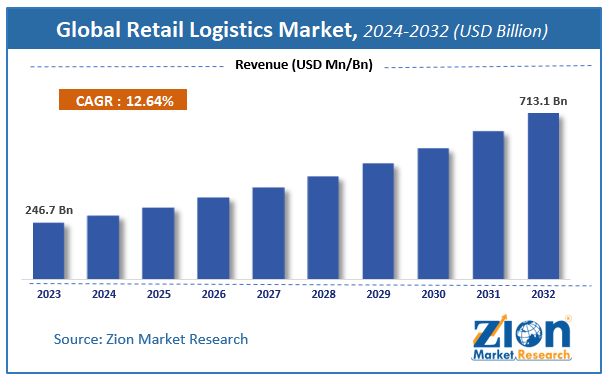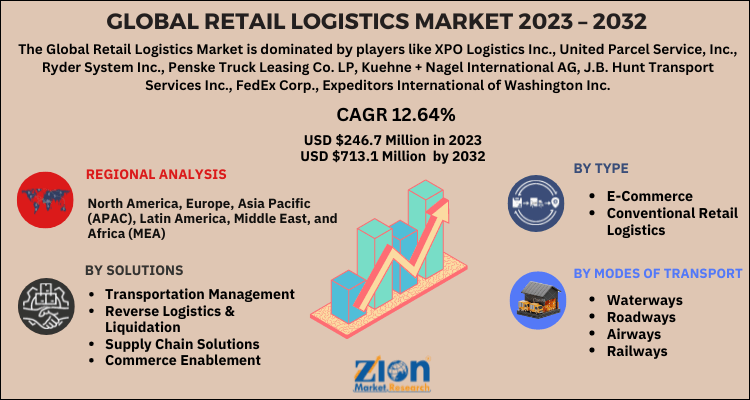Retail Logistics Market Size, Share, Trends and Forecast To 2032

Retail Logistics Market By Modes Of Transport (waterways, roadways, airways, railways, and others. ), By Solutions (transportation management, reverse logistics & liquidation, supply chain solutions, commerce enablement, and others.), By Type,(e-commerce and conventional retail logistics.) And By Region: - Global Industry Analysis, Size, Share, Growth, Trends, and Forecast, 2024-2032
| Market Size in 2023 | Market Forecast in 2032 | Growth Rate (in %) | Base Year |
|---|---|---|---|
| USD 246.7 Billion | USD 713.1 Billion | CAGR at 12.64% | 2023 |
Description
Global Retail Logistics Market: Insights
The global retail logistics market had a value of USD 246.7 billion in 2023, and according to a report by Zion Market Research, it will grow to USD 713.1 billion by the end of 2032. The market is expected to grow with a CAGR of 12.64% during the forecast period.
This study provides an analysis of the growth drivers, growth restrictions, and influence on demand that are associated with the Global Retail Logistics Market over the time of forecasting. Additionally, it will assist in navigating and investigating the possibilities that are becoming available in the Retail Logistics Market market.
Global Retail Logistics Market: Overview
Retail logistics is a streamlined process of handling complex merchandise flow, starting from the source of supply till the delivery of the product to the customer. The giant retailers, in particular, need systematic handling and planning of goods movement till the point of delivery to the customer. Retail logistics assure that the whole process is organized and customers are offered better services at affordable prices.
Global Retail Logistics Market: Growth Factors
There is a significant spike in demand for retail logistics due to the rushing global trade activities. The retail logistics system facilitates the efficient and smooth flow of durable and non-durable goods from distributors and suppliers to customers. The ongoing developments in logistics are likely to steer the growth of the global retail logistics market exponentially in the forthcoming years. Apart from that, the logistics will help retailers offer faster delivery periods at low fulfillment costs and, in addition, improve their capability to concentrate on service rather than on administrative tasks.
The international retail market is witnessing extensive competition due to surging globalization. As a result, international retailers are building new stores in developing economies like the Asia Pacific to deal with emerging obstructions. Such initiatives will fuel trade activities, lower transportation time and cost, and thereby encourage the demand for retail logistics to fast-forward product transportation. International retailing is flourishing in growing economies as export and import activities scale up tax revenue, which in turn will accelerate overall market growth. The growing penetration of the internet has also significantly scaled up the e-commerce opportunity, along with trade activities for international retailers.
In addition, consumers are also transforming their traditional buying nature, and thereby manufacturers and retailers are adopting retail logistics to meet the emerging landscape. The adoption of multi-modal transportation is likely to offer numerous benefits, like a reduced cost for vehicles, decreased cargo, handling period, and lower customs controls. However, the growing adoption of multiple means of transport is likely to be a crucial market trend, as it uses rail cars, aircraft, trucks, and ships.
However, the combination of this multi-modal transportation can significantly lower inventory costs while maintaining merchandise costs under control. However, the outbreak of the COVID-19 pandemic has significantly impacted the growth of the market and enhanced its profitability. All these aforementioned factors are likely to exponentially scale up the growth of the global retail logistics market over the forecast period.
Key Insights
- As per the analysis shared by our research analyst, the global Retail Logistics Market is estimated to grow annually at a CAGR of around 12.64% over the forecast period (2024-2032).
- In terms of revenue, the global Retail Logistics Market size was valued at around USD 246.7 Billion in 2023 and is projected to reach USD 713.1 Billion by 2032.
- Based on the modes of transport type, The roadways segment dominates the retail logistics market, accounting for approximately 51.9% of the market share in 2022. This is primarily due to its high flexibility, extensive reach in both urban and rural areas, and the critical role it plays in last-mile delivery services. The rise in e-commerce, along with better road infrastructure and government support, has further boosted the dominance of this mode in retail logistics.
- Based on the type, Conventional retail logistics is the most dominant type in the market, holding about 55% of the share in 2022. Despite the growth of e-commerce, traditional brick-and-mortar stores continue to thrive, especially in regions where internet penetration is lower. The well-established infrastructure supporting conventional retail also contributes significantly to this segment's continued strength.
- Based on the solution type, Among solution types, supply chain solutions lead the retail logistics market with a share of roughly 35.5% in 2022. The growth is driven by the increasing use of cloud-based technologies that enhance inventory tracking, order fulfillment, and reverse logistics. Retailers are focusing more on supply chain efficiency and personalized delivery experiences, making this segment the most vital.
- Based on the region, Asia Pacific emerged as the most dominant region in the retail logistics market, contributing about 36.5% of the market share in 2022. This growth is fueled by booming e-commerce, a large consumer base, and robust investments in logistics infrastructure across countries like China, India, and Japan. The rapid urbanization and digital transformation in the region further support its leading position.
Recent Developments:
- In March 2025, DCS Group, a distributor of beauty, health, and household brands, partnered with XPO Logistics. Through this collaboration, DCS Group is leveraging XPO’s advanced IT solutions and logistics expertise to enhance customer experience and strengthen its operations in the fast-growing consumer goods (FMCG) sector.
- In March 2025, FedEx partnered with Blue Yonder to launch the ‘Box-Free’ returns program. The service allows customers to return products without packaging or printed labels, simplifying the returns process and enhancing convenience.
- In November 2024, Kuehne+Nagel acquired a 51% stake in IMC Logistics, a U.S.-based provider of marine drayage services. IMC specializes in end-to-end transport solutions to and from rail hubs and seaports, as well as customer services and inland logistics across the U.S., strengthening Kuehne+Nagel’s presence in the American market.
Retail Logistics Market: Report Scope
| Report Attributes | Report Details |
|---|---|
| Report Name | Retail Logistics Market Research Report |
| Market Size in 2023 | USD 246.7 Billion |
| Market Forecast in 2032 | USD 713.1 Billion |
| Growth Rate | CAGR of 12.64% |
| Number of Pages | 201 |
| Key Companies Covered | XPO Logistics Inc., United Parcel Service, Inc., Ryder System Inc., Penske Truck Leasing Co. LP, Kuehne + Nagel International AG, J.B. Hunt Transport Services Inc., FedEx Corp., Expeditors International of Washington Inc., Deutsche Post AG, and C.H. Robinson Worldwide, Inc. |
| Segments Covered | By Modes of Transport Type, By Type, By Solution Type, and By Region |
| Regions Covered | Latin America, North America, Asia Pacific, Europe, The Middle East, And Africa |
| Base Year | 2023 |
| Historical Year | 2018 to 2022 |
| Forecast Year | 2024 - 2032 |
| Customization Scope | Customized purchase options are available to meet your exact research needs. Request For Customization |
Global Retail Logistics Market: Segmentation
The global retail logistics market can be segmented into modes of transport, solutions, types, and regions. All the segments have been analyzed based on present and future trends and the market is estimated from 2024 to 2032.
By modes of transport, the market can be segmented into waterways, roadways, airways, railways, and others. The roadways mode of transport segment accounts for the largest share in the global retail logistics market due to the surging demand for roadways vehicles for transportation of retail products for long distances in domestic regions.
By solutions, the market can be segmented into transportation management, reverse logistics & liquidation, supply chain solutions, commerce enablement, and others. The supply chain solution segment holds the largest share in the global retail logistics market as it helps in effectively processing customer returns, personalizing fitting & order fulfillment, optimizing omnichannel operations, and ensuring on-time delivery.
By type, the market can be segmented into e-commerce and conventional retail logistics. The conventional retail logistics segment dominates the global retail logistics market due to its growing adoption by consumers as it is not very dependent on the internet; therefore, conventional retail stores prefer such solutions.
The regional segment includes the current and forecast demand for North America, Europe, Asia Pacific, Latin America, and the Middle East and Africa.
Global Retail Logistics Market: Regional analysis
Asia Pacific accounts for the largest share in the global retail logistics market due to the widening scope of e-commerce and the presence of a huge customer base for retail products. Growing economies like Australia, China, Japan, and India are among the top exporters for merchandise and hold the largest share of global retail e-commerce sales. Therefore, the region is expecting strong growth prospects in the forthcoming years. The increasing concentration on enhancing transportation practices and ongoing logistic infrastructure is likely to augment the growth of the regional market in the forthcoming years.
North America is likely to be the fastest-growing region in the global retail logistics market due to the presence of prominent market leaders in the region. Also, the growing initiatives from the government to develop a highly advanced transportation system will further encourage the growth of the regional market.
Global Retail Logistics Market: Competitive Players
Some of the significant players in the global retail logistics market are
- XPO Logistics Inc.
- United Parcel Service, Inc.
- Ryder System Inc.
- Penske Truck Leasing Co., Ltd.
- Kuehne + Nagel International AG
- J.B. Hunt Transport Services, Inc.
- FedEx Corp.
- Expeditors International of Washington, Inc.
- Deutsche Post AG
- C.H. Robinson Worldwide, Inc.
The Global Retail Logistics Market is segmented as follows:
By Modes Of Transport
- Waterways
- Roadways
- Airways
- Railways
- Others.
By Solutions
- Transportation Management
- Reverse Logistics & Liquidation
- Supply Chain Solutions
- Commerce Enablement
- Others.
By Type
- E-commerce
- Conventional Retail Logistics.
Global Retail Logistics Market: Regional Segment Analysis
- North America
- The U.S.
- Canada
- Europe
- France
- The UK
- Spain
- Germany
- Italy
- Rest of Europe
- Asia Pacific
- China
- Japan
- India
- South Korea
- Southeast Asia
- Rest of Asia Pacific
- Latin America
- Brazil
- Mexico
- Rest of Latin America
- Middle East & Africa
- GCC
- South Africa
- Rest of Middle East & Africa
What Reports Provide
- Full in-depth analysis of the parent market
- Important changes in market dynamics
- Segmentation details of the market
- Former, on-going, and projected market analysis in terms of volume and value
- Assessment of niche industry developments
- Market share analysis
- Key strategies of major players
- Emerging segments and regional markets
- Testimonies to companies in order to fortify their foothold in the market.
Table Of Content
FrequentlyAsked Questions
Retail logistics is a streamlined process of handling complex merchandise flow, starting from the source of supply till the delivery of the product to the customer. The giant retailers, in particular, need systematic handling and planning of goods movement till the point of delivery to the customer. Retail logistics assure that the whole process is organized and customers are offered better services at affordable prices.
The Retail Logistics Market was valued at USD 246.7 Billion in 2023.
The Retail Logistics Market is expected to reach USD 713.1 Billion by 2032, growing at a CAGR of of 12.64% between 2024 to 2032.
There is a significant spike in demand for retail logistics due to the rushing global trade activities. The retail logistics system facilitates the efficient and smooth flow of durable and non-durable goods from distributors and suppliers to customers. The ongoing developments in logistics are likely to steer the growth of the global retail logistics market exponentially in the forthcoming years. Apart from that, the logistics will help retailers offer faster delivery periods at low fulfillment costs and, in addition, improve their capability to concentrate on service rather than on administrative tasks.
Retail Logistics Market players such as XPO Logistics Inc., United Parcel Service, Inc., Ryder System Inc., Penske Truck Leasing Co. LP, Kuehne + Nagel International AG, J.B. Hunt Transport Services Inc., FedEx Corp., Expeditors International of Washington Inc., Deutsche Post AG, and C.H. Robinson Worldwide, Inc.
HappyClients
Zion Market Research
Tel: +1 (302) 444-0166
USA/Canada Toll Free No.+1 (855) 465-4651
3rd Floor,
Mrunal Paradise, Opp Maharaja Hotel,
Pimple Gurav, Pune 411061,
Maharashtra, India
Phone No +91 7768 006 007, +91 7768 006 008
US OFFICE NO +1 (302) 444-0166
US/CAN TOLL FREE +1 (855) 465-4651
Email: sales@zionmarketresearch.com
We have secured system to process your transaction.
Our support available to help you 24 hours a day, five days a week.
Monday - Friday: 9AM - 6PM
Saturday - Sunday: Closed







